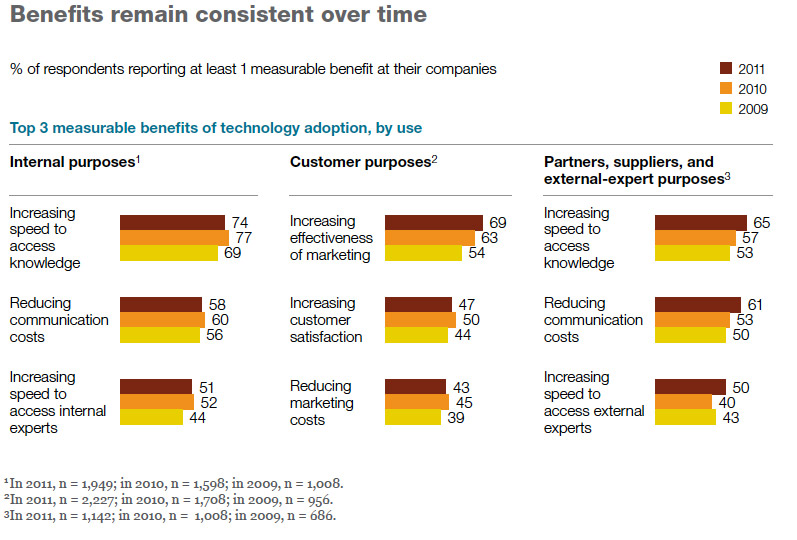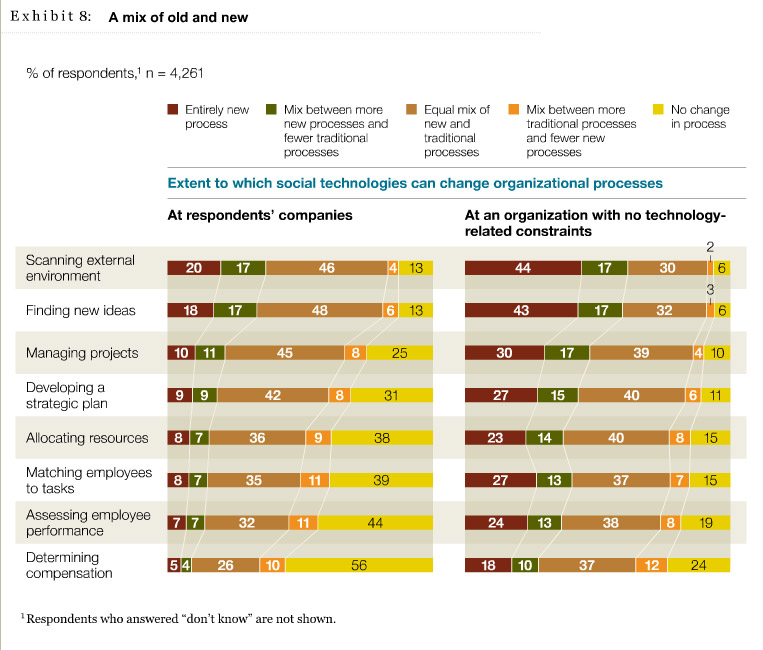By: Gianluigi Cuccureddu
The McKinsey Institute published the results of their fifth annual survey on how organizations use social technologies, it surveyed 4,200 executives to understand the developments and progress throughout the years and benefits of these social technology applications. They are being deployed for the purpose of process enhancements and operations. Secondly they’re being used to find new growth opportunities. Surprisingly, a large percentage of organizations did not maintain the benefits of using social technologies that they had achieved earlier.
Internal versus external
The results below show how internal and external (customers, partners, suppliers and experts) purposes are being sustained and enriched by social technologies.
What is striking are the differences in access to knowledge and access to experts (both from the “Internal purposes” and “Partners … purposes” perspective). Knowledge is connected to certain people and people have certain knowledge. The social technologies that are being used by the surveyed organizations do not meet these demands efficiently and effectively.
This difference can be ascribed to a technology-centric approach instead of a business approach where technologies sustain and help achieving goals.
Transformation and decline
This image below shows the shifts referred to in the first paragraph. Roughly half of the internally and externally networked enterprises slid back into the category of developing organizations. McKinsey states on this:
“It appears that it is easier to lose the benefits of social technologies than to become a more networked enterprise, which suggests that significant effort is required to achieve gains at scale. We also found initial indications that if the percentage of employees who integrated social technologies into their day-to-day work declined, their companies were more likely to backslide.”
Decline in organizational type needs attention. Social technologies need to be embedded in the organizational processes from a business point of perspective, not an IT one. If it’s done from an IT perspective, applications won’t be sustainable, less effective ultimately not benefiting from them anymore.
Processes
Just as the purposes that are being sustained by social technologies (see “Internal versus external”), there’s a discrepancy in the usage of social technologies for the different purposes. The last three processes in the illustration below sustain this discprancy. Social technologies are hardly used for “Matching employees to tasks”,”Assessing employee performance” and “Determining compensation”, but how should video sharing and RSS for instance achieve them? The mentioned technologies are not –effectively- suitable for HR processes.
We, 90:10 Group Netherlands, work with Closed Link which developed a technology called “Innerteams”. It facilitates such processes (as “Matching employees to tasks”,”Assessing employee performance” and “Determining compensation”) on an efficient and effective manner. The system matches ideas, knowledge with the right people enabling much more efficiency and effectiveness to reach out to the right people or get the right knowledge quickly. Not only does it facilitates the three processes in the image, but think of innovation management in general, employee retention and talent management as well. The dashboard provides insights on both the knowledge and people level, being able to understand hot topics, most inquired person, ratings on the matches between person and question and so on.
Culture
The image below shows the difference between the surveyed organizations and organizations with no technology-related constraints to change organizational processes. Management needs to facilitate bottom-up ownership, in order to let the organization innovate on processes with the multitude of available –social- technologies.
The image also shows that the usage of entirely new processes for the purpose of “Scanning external environment” and “finding new ideas” is a much greater percentage in organizations with no tech constraints (44 versus 20 per cent). There are many developments in technologies require an open mind and constantly investigating if new technologies can enhance processes instead of using certain –social- technologies and not being able to profit optimally.
Gartner’s predictions for 2012 show that big data is not being exploited for competitive advantage. This can have all sorts of reasons, one of them are the technology enablers that are not sufficient and up to it. Another research by McKinsey “Big data: The next frontier for innovation, competition, and productivity” concludes the following on –social- data:
“[…]established competitors and new entrants alike will leverage data-driven strategies to innovate, compete, and capture value from deep and up-to-real-time information.”
“Finding new ideas” and “Managing projects” are two interesting processes as well. Through social data new ideas and ‘its people’ can be found. Within external- and fully networked organizations this evolve in co-creation and truely extending the organization with external participation in its processes.
What results from McKinsey’s survey stands out to you? What do you think are the biggest challenges for organzations to innovate with social technologies?
By Gianluigi Cuccureddu
About the author:
 Gianluigi Cuccureddu, contributing editor, is an experienced writer specializing in innovation, open business, new media and marketing. He is also Managing Partner of the 90:10 Group, a global Open Business consultancy, which helps clients open their activity directly and indirectly to external stakeholders through the use of social media, its data and technologies for the purpose of competitive advantages in marketing, service- and product innovation.
Gianluigi Cuccureddu, contributing editor, is an experienced writer specializing in innovation, open business, new media and marketing. He is also Managing Partner of the 90:10 Group, a global Open Business consultancy, which helps clients open their activity directly and indirectly to external stakeholders through the use of social media, its data and technologies for the purpose of competitive advantages in marketing, service- and product innovation.




